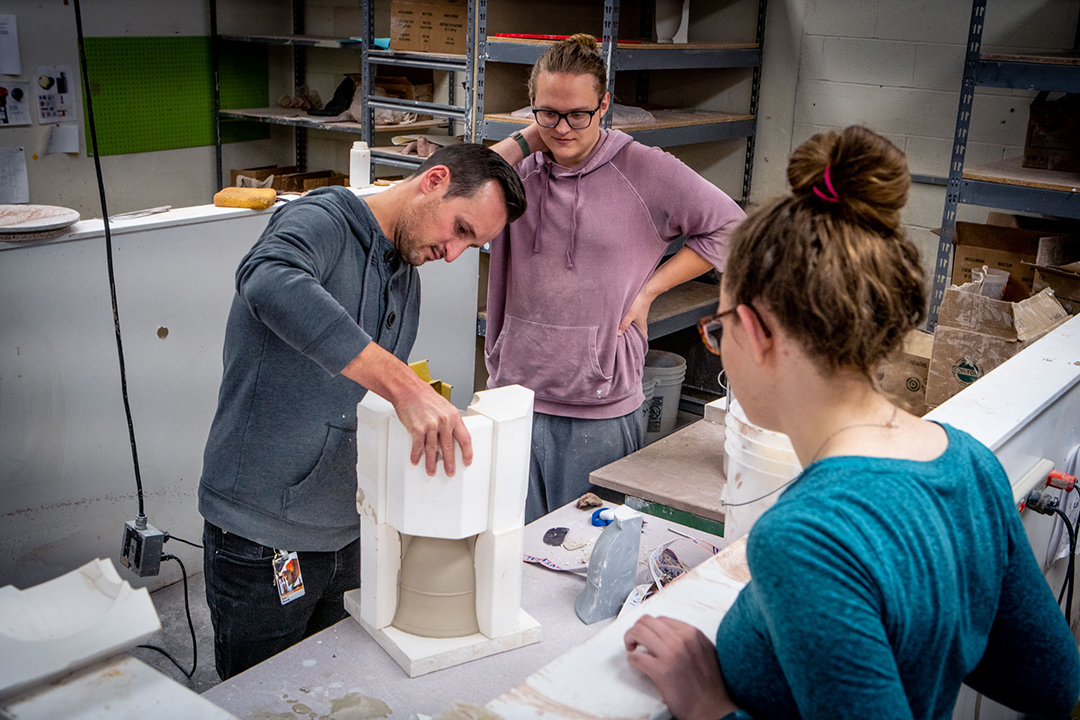Exploring art history and experimenting with clay in an interdisciplinary classroom
Ceramics course open to all majors provides the opportunity to learn through making
Scott Hamilton
Peter Pincus, left, helps Ethan Sandwick, center, demold his latest class project, which involved creating 3D printed plaster molds to slip cast a ceramic vessel.
Monday and Wednesday mornings in the ceramics studio of RIT’s College of Art and Design have been filled with conversation and collaboration throughout the fall semester during a unique course called Josiah Wedgewood’s Legacy. The course is an opportunity for students of all majors to get their hands dirty with clay and engage with art history and ceramics education in a new way.
Developed and taught by Assistant Professor Peter Pincus, the course’s curriculum is a unique meld of art history, philosophy, and ceramics education and encourages students to explore and learn freely through experimentation and trial and error.
“We essentially focus on the interpretation of ceramic art history through the practical development of studio skill and the academic pursuit of studying. Students are splitting their time between traditional research and creating in the studio, and we use the materials to try to walk in the footsteps of this famous potter, Josiah Wedgewood, who led this sort of neoclassical industrial revolution in the 18th century.”
Wedgewood, a multifaceted business man, became one of the first European tycoons by recreating, manufacturing, and marketing ceramic artifacts from 4th century Greece. Etruscan vessels and design elements were popular among aristocrats in Europe at the time, according to Pincus, and by making mass-produced replicas, Wedgewood made the objects more accessible to a larger market.
“He was a leader in the industrial revolution, but he was also highly political. He was an abolitionist and he created ceramics that sort of spread the message of equality as best as one could spread it at that time,” said Pincus. “So you have this really precarious figure who sort of straddles all of these different worlds of manufacturing, art, and social practice, but also one that used those platforms to become excruciatingly wealthy. I see him as a pivotal world figure—for better or for worse—that we can all learn from.”
Pincus’s course takes the phrase “hands-on education” literally and allows for students with no prior experience with clay or plaster to dive in and create using resources that would otherwise only be available to art and design majors. Opening up the course to majors across the university gives more students the chance to see if they’d like to make art a larger part of their life.
Before enrolling in this course, third-year civil engineering technology student Ethan Sandwick, from Corinth, N.Y., hadn’t taken an art class since middle school, but it was always something he enjoyed. Jumping back into art reminded him of the importance of winging it sometimes and stepping out of your comfort zone.
“It’s a good branching out experience, to step away from what you’ve always known you wanted to do and experience something else that can just be an outlet throughout your life. I think I could make plaster molds and do slip casting fairly easily in my own house and it's just a cool thing that I can do now,” said Sandwick. “I’ve also always been someone who liked to plan everything out, and in this class it’s been less about planning and more about just starting somewhere and seeing where I go with it. It’s more carefree.”
All of the course’s projects include a contemporary spin, whether it be incorporating pop culture or integrating technology like 3D printing. As one of their first projects, students participate in a Nailed It style challenge where they are tasked to recreate a masterfully-designed ceramic vessel with little to no experience with the craft. The final object rarely turns out as planned, but students aren’t actually graded on them. Instead, the focus is on their understanding of replication in the creative sphere.
“A big part of craft discipline is studying history through the production of objects, and we need to be sensitive about where ideas come from and how things become referenced,” said Pincus. “I thought a course like this would be a great place to get students to confront this topic of appropriation at the front end of their education.”
Pincus says that freeing the students from the anxiety of being graded on their creations also instills a fearlessness in them when they tackle new projects. By cultivating an atmosphere that embraces experimentation and failure, students are more confident taking creative risks.
Elliott Connelly, a second-year student from Rochester, N.Y., just changed his major to studio arts: ceramics option this semester and has enjoyed the freedom to explore in this course.
“When it comes to the creative process, experimentation is so important. Through this whole class, Peter has not given us many demonstrations, which I’m not used to. We’ll get an assignment and he will tell us to get to experimenting. We all end up trying new things and trying to figure out how all of this works, and I think it has definitely helped in forcing me to be more creative than I might in other situations,” said Connelly.
The Josiah Wedgewood’s Legacy course was developed by Pincus, with special thanks to Jane Shellenbarger, Christine Shank, and Sarah Thompson. For more information, email Peter Pincus at pjpsac@rit.edu.







